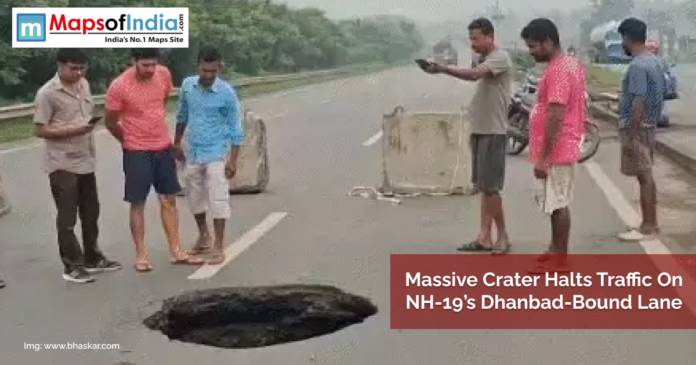A huge landslide on National Highway-19 (earlier NH-2) adjacent to Asansol has resulted in the formation of a 20-feet deep crater on the Dhanbad-bound lane, virtually halting the circulation of traffic and leaving denizens startled. It happened at the start of Monday morning and has since left one of the busiest sports corridors in Eastern India with a traffic jam.
The giant crater is said to have been formed following soil wash-away after days of intermittent heavy rainfalls in the area. The damaged part of the road collapsed without warning, creating a hole smack in the middle of the road. Luckily, no one was reported dead at the moment of the collapse since the lane was rather less congested at the time of the morning.
The landslide has fully obstructed the carriageway leading to Dhanbad, prompting the authorities to stop the vehicular traffic and channelise the traffic to go otherwise. Pictures of long lines of trucks, buses, as well as personal vehicles, were witnessed jamming up the road preparations concerning the rush of news that the road had collapsed among transporters and passengers.
Emergency action was also fast in coming with local administrations and highway authorities on the scene and bringing with them engineers, a rescue team, and heavy equipment to check the damage. Barricades have also been placed on the entrance and departure of the affected stretch to stop any accidents, and traffic police have been deployed to tackle the diversion and help stranded commuters.
The crater is estimated to be more than 20 feet deep and several meters wide, and therefore, no temporary patchwork could be done. Authorities have taken urgent repair steps and this is estimated to take at least between 24 to 48 hours, depending on weather and on the stability of the soil.
Train commuters coming toward Dhanbad, through Kolkata or Asansol, have been requested to switch to alternative routes, through Chittaranjan or Nirsa. The services in the public transport system, such as long-distance buses and those that transport goods, have also suffered from the delays projected to continue in the next couple of days. Officials in the transport sector have encouraged passengers to check on route updates before commencing travel.
The accident has called into question the engineering background and maintenance programs of key highways such as those passing through the rain-prone and hilly terrains. The inhabitants of nearby regions said that they heard a thunderous sound as a section of the road crumbled and fell. People also had fears of how often such accidents are likely to occur, particularly in the rainy season.
On the site, engineers and geologists are reviewing the soil situation in order to make sure that no other cave-ins take place. It is anticipated that a long-term remedy that would involve stabilising the embankment, followed by the appropriate drainage mechanisms, would be addressed once the first-time repair has been ensured.
There is yet to be a definite schedule the complete restoration of the damaged lane will be restored as of today, but the government has promised the citizens that roads are being constructed on war footing, which is why there has been constant traffic congestion along the axis. Till that time, the traffic on NH-19 in Asansol can be expected to be hampered, diversions and jams on the highway are likely to continue to cause inconvenience to the commuters and trans-border transportation.
A huge landslide on National Highway-19 (earlier NH-2) adjacent to Asansol has resulted in the formation of a 20-feet deep crater on the Dhanbad-bound lane, virtually halting the circulation of traffic and leaving denizens startled. It happened at the start of Monday morning and has since left one of the busiest sports corridors in Eastern India with a traffic jam.
The giant crater is said to have been formed following soil wash-away after days of intermittent heavy rainfalls in the area. The damaged part of the road collapsed without warning, creating a hole smack in the middle of the road. Luckily, no one was reported dead at the moment of the collapse since the lane was rather less congested at the time of the morning.
The landslide has fully obstructed the carriageway leading to Dhanbad, prompting the authorities to stop the vehicular traffic and channelise the traffic to go otherwise. Pictures of long lines of trucks, buses, as well as personal vehicles, were witnessed jamming up the road preparations concerning the rush of news that the road had collapsed among transporters and passengers.
Emergency action was also fast in coming with local administrations and highway authorities on the scene and bringing with them engineers, a rescue team, and heavy equipment to check the damage. Barricades have also been placed on the entrance and departure of the affected stretch to stop any accidents, and traffic police have been deployed to tackle the diversion and help stranded commuters.
The crater is estimated to be more than 20 feet deep and several meters wide, and therefore, no temporary patchwork could be done. Authorities have taken urgent repair steps and this is estimated to take at least between 24 to 48 hours, depending on weather and on the stability of the soil.
Train commuters coming toward Dhanbad, through Kolkata or Asansol, have been requested to switch to alternative routes, through Chittaranjan or Nirsa. The services in the public transport system, such as long-distance buses and those that transport goods, have also suffered from the delays projected to continue in the next couple of days. Officials in the transport sector have encouraged passengers to check on route updates before commencing travel.
The accident has called into question the engineering background and maintenance programs of key highways such as those passing through the rain-prone and hilly terrains. The inhabitants of nearby regions said that they heard a thunderous sound as a section of the road crumbled and fell. People also had fears of how often such accidents are likely to occur, particularly in the rainy season.
On the site, engineers and geologists are reviewing the soil situation in order to make sure that no other cave-ins take place. It is anticipated that a long-term remedy that would involve stabilising the embankment, followed by the appropriate drainage mechanisms, would be addressed once the first-time repair has been ensured.
There is yet to be a definite schedule the complete restoration of the damaged lane will be restored as of today, but the government has promised the citizens that roads are being constructed on war footing, which is why there has been constant traffic congestion along the axis. Till that time, the traffic on NH-19 in Asansol can be expected to be hampered, diversions and jams on the highway are likely to continue to cause inconvenience to the commuters and trans-border transportation.










